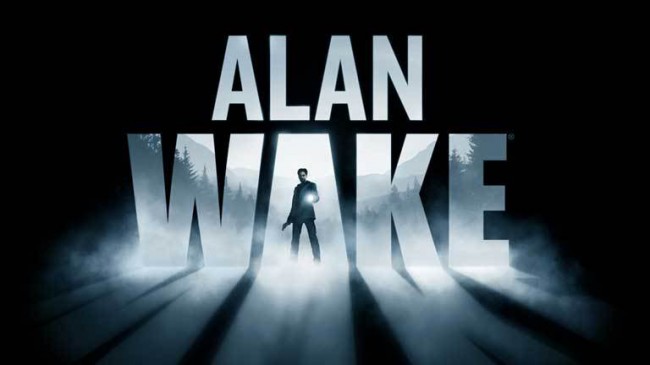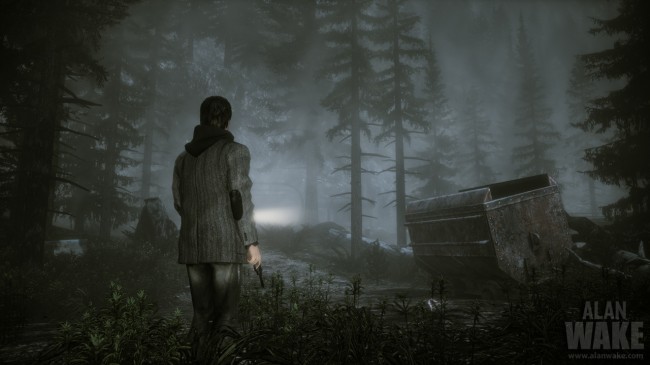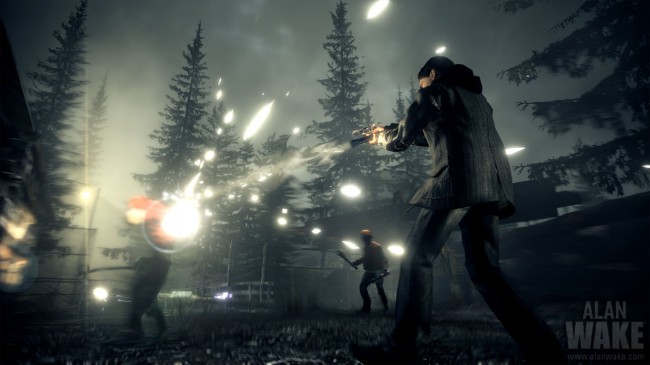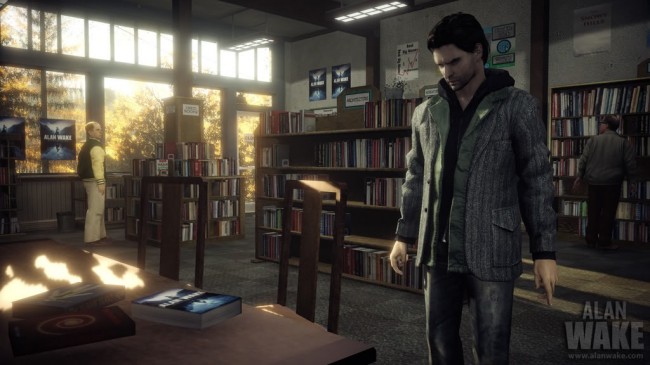Alan Wake is a game that puts its protagonist in a situation where they must reunite with a loved one by using light to overcome the darkness. Videogames usually have similar struggles occurring within them to give the player enough incentive to take part in the game and keep playing. But there’s also the meta-struggle — the game developer’s fight to make a meaningful connection between the story and game mechanics in their work.
Take Mirror’s Edge, for example. Its story was sufficient enough to give the player some motivation towards getting Faith from Point A to Point B. The game’s strength was in its first-person platforming, while its story bore little significance in what the game was trying to accomplish. We see the opposite with Heavy Rain — a game that succeeded in stirring emotion in a player through plot-events, yet restricted the player to quick-time events. This union between story and mechanic is rarely made.
Alan Wake is a videogame that succeeds in uniting story and mechanic in a truly meaningful way — and the result is an experience that is greater than either could ever be on their own.
Alan Wake is a third-person shooter that takes place in the strange, secluded town of Bright Falls. As a writer who is currently lacking inspiration, Wake looks to spend some time in Bright Falls to get away from work for awhile. His wife disappears soon after their arrival, and Wake sets out to find her. As he ventures out to find the whereabouts of his wife, he finds pages of a novel he doesn’t remember writing — only to find that the events that occur on each page are actually coming true. This is where the psychological thriller bit comes into play; the story continues, and you never really know what’s happening for most of the game.
However, one thing is known for sure: in darkness — fight with light. This is the rule that governs the plot and shooting mechanic. The darkness that is corrupting Bright Falls is sensitive to light. Flashbangs and flare guns will be some of your most powerful weapons; lamp posts are your save havens; a flashlight becomes your best friend. Wake’s enemies are engulfed in darkness, and he has use his flashlight to burn the darkness — or shields — off of his enemies before he can dispatch them. In a clever design choice by Remedy, the flashlight beam also acts as the aiming reticule.
The combat is the most satisfying when you find yourself outnumbered because managing your enemies as they approach involves strategy. While wearing down an enemy’s shield, you’ll have to dodge the attacks of nearby enemies while making sure that your flashlight has fresh batteries and your gun is loaded. You know you’ve dodged correctly when you’re rewarded with a dramatic slow-motion effect — which becomes both a relief and stressful when you see it. If you’re feeling swamped, dropping a flare will buy you some time to run away, change batteries, get to a safe haven, or reload guns. This all sounds complicated on paper, but reloading and changing batteries just involve a button tap — and dodging is just as easy. The combat in Alan Wake is elegant because it’s simple, yet it forces players to be strategic with their actions.
Alan Wake’s plot is just as enthralling. As the story moves forward and certain bits of information are revealed to the player, this theme of “light and dark” remains prevalent. Moreover, Remedy designed Alan Wake in such a way that always reminded me of the story as I played. I could be fighting dudes in the middle of the woods at night or driving around in daylight, but certain design choices always told me, “Hey, something bigger is happening here.”
Remedy provides the player with a number of ways to learn about the plot and the town of Bright Falls. Radios will unveil information about the town and tell you about other things that are occurring at that moment in time. Televisions act as windows into Wake’s mind and can also provide entertainment that will set the mood for certain parts of the game. Finding radios and televisions will net you some achievement points. But more importantly, they act as “literary devices” for the game that either set the mood or tell you more about Wake and Bright Falls. Alan Wake makes finding these collectibles significant. Thoughtful design choices like these take collectibles — usually a drab component of a game — and use them to flesh out the plot and setting.
Alan Wake shows high production value where it’s important. Facial expressions sometimes look weird and voice-overs may not be synced to animations properly, but the lighting in Alan Wake is amazing. The light behaves and looks realistic in both cutscenes and gameplay For a game that’s based on light and darkness, getting this right was vital.
Instead of levels, Alan Wake is divided into episodes which span about 10-12 hours of play. What’s notable here is that at the end of each level, there’s a dramatic ending that makes you want to keep playing — you’re shown a story-twisting cutscene, music hits, the camera pans out, and you see the Alan Wake logo. For me, seeing the logo quickly took me out of the game; it signaled a moment for me to take a breather and gather my thoughts. But after each episode, I immediately wanted to dive in and play more. It’s much like an episodic drama that you’d watch on network television. These transitions do an excellent job of making things more dramatic.
Game developers shouldn’t be held to a standard where they are forced to have the stories of their videogames resonate with their gameplay or vice versa. In fact, all games shouldn’t be like this. However, the fact that Remedy achieved this resonance in Alan Wake is what makes this game unique.
Sometimes while critiquing or discussing videogames, one often gets into the habit of throwing around the phrase “gaming experience.” Alan Wake has shed some light on that phrase for me. The way its story and gameplay thrived off of one another always kept me immersed and wanting to play more of it. The lightning effects, television shows, and radios in Alan Wake highlighted its story really well. Remedy constantly kept me engaged in the world they created by allowing me to play and learn in a variety of contexts. This is why Alan Wake is brilliant; it’s an authentic, high-order gaming experience.
This review is based on a retail copy of Alan Wake purchased by the writer. All images courtesy of Remedy Entertainment.







2 Comments